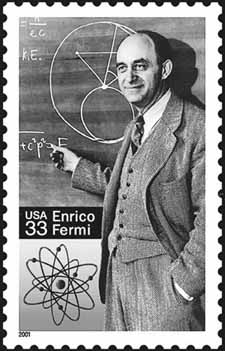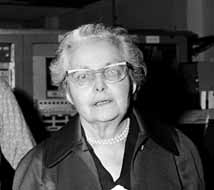 |
|
Fermi Stamp: A Chain Reaction by Mike Perricone
"There have been a number of postage stamps honoring Nobel Prize winners, and 20 or 30 years ago the idea would have been perfect," said Goodman, a Fermilab user from Argonne National Laboratory and a lifelong stamp collector. "But the Postal Service has become more interested in stamps for Marilyn Monroe and Bugs Bunny, so we knew we had a bit of a battle on our hands. The USPS has become more market oriented. But that's OK, too." Sure enough, the 2001 series of commemorative stamps from the Postal Service includes an actress (Lucille Ball) and cartoon characters (Peanuts and Looney Tunes). But the USPS will also issue a stamp in Chicago on September 29, 2001 commemorating the 100th anniversary of Fermi's birth (actually September 29, 1901 in Rome, Italy). As a member of Fermilab's Users Executive Committee in 1998, Goodman helped launch the idea of the stamp as an outreach effortówith or without the expectation of an approval from the Citizen's Stamp Advisory Committee, which considers submissions and makes the decision for the Postal Service. Initially aiming at recognizing the new Main Injector at Fermilab, the campaign settled on Fermi's 100th anniversary as a more specific date and a more tangible goal. The campaign grew with additional endorsements from Universities Research Association, Inc., which operates Fermilab under contract with the U.S. Department of Energy; from the lab's neighboring cities of West Chicago, Warrenville, Batavia and Aurora; from the DuKane Valley Council; and with support from individuals across the United States and from 15 other nations. "Did we actually have an effect on the decision? I don't know," Goodman admitted. "We did what we did, and we had fun with it." The citation accompanying the stamp describes Fermi as "one of the preeminent physicists of the atomic age." He won the 1938 Nobel Prize in Physics for the discovery of nuclear reactions brought about by slow neutrons. In 1942, he directed the first controlled and self-sustaining man-made nuclear chain reaction with the Manhattan Project, the U.S. effort to build the first atomic bomb. The stamp art includes a colorized black-and-white photograph of Fermi taken in 1948 and a model of the carbon atom. Graphite, a form of carbon, was used to slow down the neutrons in the first nuclear reactor.
The laboratory took on Fermi's name in 1974, with efforts dating back to 1967 and the introduction of a bill in Congress by Rep. Frank Annunzio of Illinois proposing the name change. Fermilab archivist Adrienne Kolb, who has closely tracked the rechristening process, noted AEC Chairman Glenn T. Seaborg's plan in April 1969 to name the 200 BeV accelerator after Fermi, affirmed by a letter from President Richard Nixon. Sen. John Pastore of Rhode Island took up the cause of naming the entire laboratory after Fermi. It was Pastore who engaged in the memorable exchange with Wilson during hearings of the Joint Congressional Committee on Atomic Energy in 1969, asking Wilson the value of the accelerator to national defense. Wilson replied: "Öit has nothing to do directly with defending our country, except to make it worth defending."
Wilson, as he did so often, defined the moment with his words.
"We are deeply honored to have the name of Fermi attached to our laboratory," he said. Then he spoke directly to Laura Fermi: "Laura, I pledge in your name that we will do our best to make this a laboratory worthy of the name of Enrico Fermi."
|
| last modified 2/2/2001 email Fermilab |
FRLsDFx9eyfrPXgV
 Maury Goodman didn't hold out much hope for the official stamp of approval from the U.S. Postal Service in commemorating either research at Fermilab, or the 100th anniversary of Enrico Fermi's birth.
Maury Goodman didn't hold out much hope for the official stamp of approval from the U.S. Postal Service in commemorating either research at Fermilab, or the 100th anniversary of Enrico Fermi's birth.
 Fermi, who worked and taught at the University of Chicago, knew Robert Wilson, Fermilab's founding director, as a colleague on the Manhattan Project. But Fermi, who died in 1954, never saw Fermilab, or knew of its creation. The U.S. Atomic Energy Commission selected the site for the National Accelerator Laboratory in 1966, and Wilson was appointed director in 1967.
Fermi, who worked and taught at the University of Chicago, knew Robert Wilson, Fermilab's founding director, as a colleague on the Manhattan Project. But Fermi, who died in 1954, never saw Fermilab, or knew of its creation. The U.S. Atomic Energy Commission selected the site for the National Accelerator Laboratory in 1966, and Wilson was appointed director in 1967.
 The wind-blown decorative flags and pennants were plastered against the sky for the dedication ceremonies at the lab on Saturday, May 11, 1974. Fermi's widow, Laura Fermi, who had fled Fascist Italy with her husband in 1939, withstood the prairie gusts at the podium and compared particle accelerators to the great pyramids of Egypt: "Both were tangible victories of men over the brute power of nature."
The wind-blown decorative flags and pennants were plastered against the sky for the dedication ceremonies at the lab on Saturday, May 11, 1974. Fermi's widow, Laura Fermi, who had fled Fascist Italy with her husband in 1939, withstood the prairie gusts at the podium and compared particle accelerators to the great pyramids of Egypt: "Both were tangible victories of men over the brute power of nature."